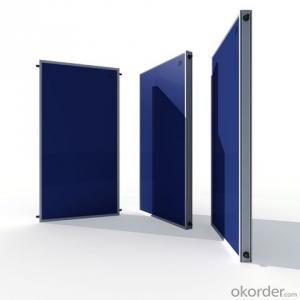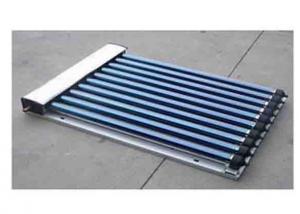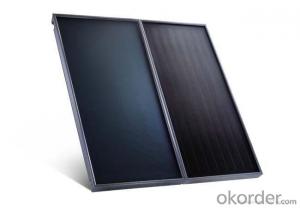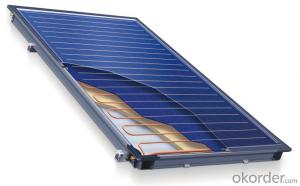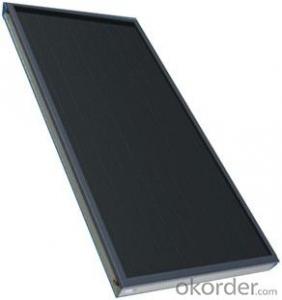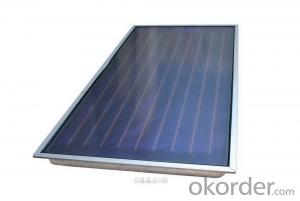Split pressurized solar collector,vacuum tube solar thermal collector
- Loading Port:
- Shanghai
- Payment Terms:
- TT OR LC
- Min Order Qty:
- 500 pc
- Supply Capability:
- 10000 pc/month
OKorder Service Pledge
OKorder Financial Service
You Might Also Like
Application:
Our flat plate solar thermal collector is suitable for residential or commercial solar water heating projects, such as hot water for real estate, hotel, factory hospital, school, swimming pool, central heating, floor heating, etc.
Warranty:
5 years international warranty for Flat Plate Solar Collector due to original quality problems.
Component Description:
Flat Plate Panel Solar Collector is one of the most wide-used solar collector with high efficiency, the selective coated absorber sheet absorbs up to 95% of available sunlight converting into usable heat, the heat is normally absorbed by water in the loop, or a freeze-resistant water mixture which is used to supplement hot water heating or house air heating.
--Glazing Glass: Toughened low-iron glass (glazing) protects the absorber from the outside environment while allowing through more than 91% of sunlight.
--Absorber: A thin sheet of aluminum is coated with a highly selective anodic oxidation / black chrome / blue titanium coating that is extremely efficient at absorbing sunlight and converting it into usable heat. The aluminum sheet is ultrasonically welded / laser welded to the copper riser pipes.
--Insulation: The insulation helps reduce heat loss from the sides and back of the collector. High-density polyurethane and glass wool to greatly reduce weight and heat lost of the collector.
--Riser & Header Pipe: Conforms to international standards, the header and riser pipes are brazed together to form a harp shaped heat exchanger that the solar system water or fluid circulates through. The absorber sheet is ultrasonically welded / laser welded to the riser pipes, thus transfers heat to the water or heat transfer fluid.
--Casing: Anodized aluminum alloy sheet seals the back and frame of the panel and adds to the rigidity of the collector. The rails in the frame are designed for easy mounting attachment.
Features:
1. Most wide-used and practical collector in solar water heating system
2. Wide applications for water heating, pool heating, space heating
3. Large solar heating capacity up to 500,000 Liter hot water
4. Much safe and stable performance with little maintenance
5. High efficient direct or indirect solar water heating
6. Strong adaptability to flat or slope roof installation
7. Easy installation and connection with simple structure
8. Super anti-freezing performance with glycol-water mixture
9. Applicable to passive and active solar water heating system
10. 10 years project installation experience
Advantages:
Comparing with vacuum tube solar collector:
1. High pressure solar collector
2. Anti-freezing with heat transfer liquid
3. More simple collector installation
4. More strong and safe collector with tempered glass glazing
5. Traditional solar collector with more market share
6. Enjoys much more popularity in warm area
7. No working angle limitation
Comparing with heat pipe solar collector:
1. More economical solar collector
2. More simple collector installation
3. More strong and safe collector with tempered glass glazing
4. Traditional solar collector with more market share
5. Enjoys much more popularity in warm area
6. No working angle limitation
- Q:How do solar collectors perform in areas with high levels of airborne debris?
- Solar collectors can still function effectively in areas with high levels of airborne debris, although their efficiency may be slightly diminished. Airborne debris, including dust, pollen, and leaves, can accumulate on the surface of the solar collectors and hinder the amount of sunlight reaching the absorber plate. Consequently, this can result in a decrease in the amount of heat generated by the collectors. Nonetheless, modern solar collectors are designed to be efficient and somewhat self-cleaning. Many collectors are equipped with a smooth surface and are tilted at an angle to prevent debris buildup. Furthermore, certain collectors come with automatic cleaning mechanisms, such as brushes or water sprays, that periodically remove debris. Maintaining and cleaning the solar collectors regularly is crucial in areas with high levels of airborne debris. This may involve manual removal of accumulated debris or using water or air pressure to clean the surface. By ensuring the collectors remain clean, their performance can be maintained at optimal levels. It is important to note that the impact of airborne debris on solar collector performance can vary depending on the type and thickness of the debris, as well as the specific design and technology of the collectors. In some instances, the reduction in efficiency may be minimal, while in others, it could be more significant. To accurately assess the exact impact, it is advisable to consult with a solar energy professional who can provide a more precise evaluation based on the specific conditions and characteristics of the area.
- Q:Can solar collectors be used in areas with limited access to skilled technicians?
- Yes, solar collectors can be used in areas with limited access to skilled technicians. Solar collectors are designed to be user-friendly and require minimal maintenance. They are generally easy to install and can be operated by individuals with basic technical knowledge. Additionally, manufacturers often provide detailed installation and maintenance manuals, as well as customer support, to assist users in such areas. Therefore, even with limited access to skilled technicians, solar collectors can still be successfully implemented and utilized.
- Q:Can solar collectors be used in regions with extreme temperatures?
- Yes, solar collectors can be used in regions with extreme temperatures. Solar collectors are designed to withstand various weather conditions, including extreme heat or cold. However, the efficiency and performance of solar collectors may be affected by extreme temperatures, and appropriate design and insulation measures need to be taken to optimize their functioning in such regions.
- Q:Are there any restrictions or regulations for installing solar collectors in certain areas?
- In certain areas, it is possible to encounter restrictions or regulations when it comes to the installation of solar collectors. These restrictions can differ based on the regulations and local government in place. Some common limitations include zoning laws, building codes, and rules set by homeowner associations. For instance, zoning laws might stipulate where solar collectors can be placed, including setbacks from property lines or height limitations. Building codes may demand specific permits or inspections to ensure the safety and structural integrity of solar collector installations. Homeowner associations could also have their own regulations pertaining to the visual appeal and positioning of solar collectors. Furthermore, certain regions might have unique regulations in place for historic districts or protected landscapes, which could limit the installation of solar collectors. Therefore, it is crucial for individuals or businesses interested in installing solar collectors to conduct thorough research and grasp the specific restrictions or regulations applicable to their area prior to proceeding with the installation process.
- Q:Do solar collectors require direct sunlight to operate?
- No, solar collectors do not require direct sunlight to operate. They can still generate electricity or heat even in cloudy conditions, although their efficiency may be reduced compared to direct sunlight.
- Q:Can solar collectors be used for heating emergency response facilities?
- Yes, solar collectors can be used for heating emergency response facilities. Solar thermal systems can effectively capture the sun's energy and convert it into heat, which can then be utilized for heating purposes in emergency response facilities. This renewable energy source can provide a sustainable and reliable heating solution, reducing reliance on traditional fossil fuels and minimizing the environmental impact.
- Q:Can solar collectors be used for heating beverage production facilities?
- Yes, solar collectors can definitely be used for heating beverage production facilities. Solar thermal collectors can capture and convert sunlight into heat energy, which can be utilized for various heating applications, including heating water for beverage production. This can help reduce reliance on traditional fossil fuels and lower energy costs while promoting sustainability in the production process.
- Q:Can solar collectors be used in solar thermal desalination?
- Solar thermal desalination can utilize solar collectors to convert seawater or brackish water into fresh drinking water using solar energy. These collectors, such as flat-plate collectors or parabolic troughs, capture and concentrate the sun's energy, which is then used to heat the water and generate steam. The steam is condensed to produce fresh water, while the concentrated brine is disposed of. Solar collectors play a crucial role in the process as they provide the necessary heat energy without relying on fossil fuels or electricity. By harnessing abundant and renewable solar energy, solar collectors make solar thermal desalination an environmentally friendly solution for addressing water scarcity in arid regions.
- Q:How do solar collectors perform in dusty environments?
- Solar collectors generally perform well in dusty environments, although the accumulation of dust on the collector's surface can reduce its efficiency over time. Regular cleaning and maintenance are necessary to ensure optimal performance. Some collectors are designed with self-cleaning mechanisms or coatings to minimize dust buildup, enhancing their longevity and efficiency even in dusty conditions.
- Q:Can solar collectors be used in areas with limited access to government assistance?
- Yes, solar collectors can be used in areas with limited access to government assistance. Solar energy systems are a viable option for individuals or communities in remote or underserved areas as they operate independently of the grid and can provide reliable and sustainable power. Installing solar collectors can help these areas become more self-sufficient and reduce dependency on government assistance for electricity needs.
1. Manufacturer Overview |
|
|---|---|
| Location | |
| Year Established | |
| Annual Output Value | |
| Main Markets | |
| Company Certifications | |
2. Manufacturer Certificates |
|
|---|---|
| a) Certification Name | |
| Range | |
| Reference | |
| Validity Period | |
3. Manufacturer Capability |
|
|---|---|
| a)Trade Capacity | |
| Nearest Port | |
| Export Percentage | |
| No.of Employees in Trade Department | |
| Language Spoken: | |
| b)Factory Information | |
| Factory Size: | |
| No. of Production Lines | |
| Contract Manufacturing | |
| Product Price Range | |
Send your message to us
Split pressurized solar collector,vacuum tube solar thermal collector
- Loading Port:
- Shanghai
- Payment Terms:
- TT OR LC
- Min Order Qty:
- 500 pc
- Supply Capability:
- 10000 pc/month
OKorder Service Pledge
OKorder Financial Service
Similar products
New products
Hot products
Hot Searches









